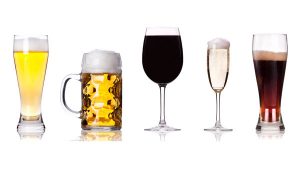
Let’s face it, it’s hard seeing the benefits of a healthy diet and exercise when we’re always going out for some drinks with friends. Beer is filling and full of carbs, mixed drinks are too sugary, and wine… well, these are nights of debauchery. How can we drink our alcohol and have flat stomachs too?
DRINK LIQUOR NEAT OR ON THE ROCKS, AVOID MIXERS
Straight liquor, though not so tasty, is healthiest if served neat (alone and meant to be sipped) or on the rocks (with a little ice). That means vodka, gin, whiskey, and scotch are all fair game. It’s the clearer types of alcohol, however, that go easier on the body. They also go easier on calories. One serving of vodka contains only 97 calories and zero carbs, while a serving of gin has about 110 calories and zero carbs. Whiskey and Scotch actually have some flavour though, and for the most part, they stick within the caloric range of gin and vodka.
BEER: MY HEART SAYS NO, BUT MY MIND SAYS YES
Beer is delicious. Unfortunately, almost every beer you drink will be high in calories and carbs. It will get you full and you will develop a beer belly. Drinking beer healthily is where simply trading off becomes the ultimate sacrifice. According to Beer100, the majority of beers come in at over 130 calories, and finding one that has less than, say, five grams of carbs is near impossible — some have as many as 24 grams.
If you’re going to try to avoid light beers and still be healthy, Guinness and other stouts are a good option. More often than not, stouts are made with whole grains, which give them their darker, caramel flavour. Compared to a lager, both have vitamins B12 and soluble fiber, but only stouts have antioxidants. Some evidence even suggests these antioxidants can have the same health benefits as wine, by reducing the risk of blood clots and other heart problems.
WINE
OK fine, the night ended up being a little classier than expected. Wine is a pretty healthy alternative to hard liquor — it’s also much tastier if you’re not used to them. Although a 5-ounce serving may be a slightly heftier 100 to 150 calories, and about 5 grams of carbs. Essentially, drinking healthily is a tradeoff. For a few extra calories and carbs, wine has a few proven health benefits, which are believed to come from high concentrations of the antioxidant resveratrol. Studies have shown that the antioxidant may be able to lower bad cholesterol while boosting good cholesterol, as well as reduce the risk of depression, cancer, and diabetes.
EAT! AND DRINK WATER
Although these are all healthier ways to drink, the key to “healthy” drinking is really moderation. One way to do this is drinking water in-between alcoholic drinks. It will help you gauge how much you’ve had, how drunk you are, and whether or not you should stop. To an extent, drinking water after a night out can also prevent a hangover.
Eating food before you start drinking — especially something with starch or dairy — can coat the stomach in preparation for the alcoholic attack it’s about to endure and prevent symptoms like nausea, upset stomach, and headaches, according to Forbes. On top of that, the food will soak up some of the alcohol, mediating the body’s process of absorbing alcohol.
If you didn’t get a chance to eat before you started drinking, there’s no better time than the present. Drinking on an empty stomach has been shown to get people drunk faster, and getting drunk faster could lead to more drinking as the night goes on. Instead, try eating something — celery, carrots, nuts, or even dinner — while you drink. The trick is to be smart about what you’re eating, and to avoid letting alcohol-induced inhibitions sway you toward fattier foods like pizza or fast foods.